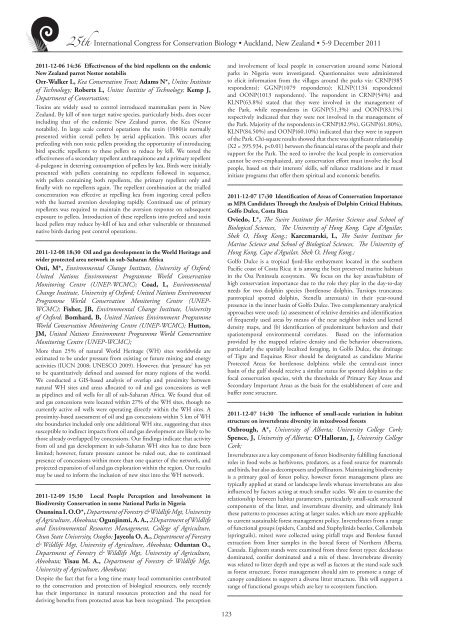Abstracts available here - Society for Conservation Biology
Abstracts available here - Society for Conservation Biology
Abstracts available here - Society for Conservation Biology
Create successful ePaper yourself
Turn your PDF publications into a flip-book with our unique Google optimized e-Paper software.
25th International Congress <strong>for</strong> <strong>Conservation</strong> <strong>Biology</strong> • Auckland, New Zealand • 5-9 December 2011<br />
2011-12-06 14:36 Effectiveness of the bird repellents on the endemic<br />
New Zealand parrot Nestor notabilis<br />
Orr-Walker L, Kea <strong>Conservation</strong> Trust; Adams N*, Unitec Institute<br />
of Technology; Roberts L, Unitec Institite of Technology; Kemp J,<br />
Department of <strong>Conservation</strong>;<br />
Toxins are widely used to control introduced mammalian pests in New<br />
Zealand. By kill of non target native species, particularly birds, does occur<br />
including that of the endemic New Zealand parrot, the Kea (Nestor<br />
notabilis). In large scale control operations the toxin (1080)is normally<br />
presented within cereal pellets by aerial application. This occurs after<br />
prefeeding with non toxic pellets providing the opportunity of introducing<br />
bird specific repellents to these pellets to reduce by kill. We tested the<br />
effectiveness of a secondary repellent anthraquinone and a primary repellent<br />
d-pulegone in deterring consumption of pellets by kea. Birds were initially<br />
presented with pellets containing no repellents followed in sequence,<br />
with pellets containing both repellents, the primary repellent only and<br />
finally with no repellents again. The repellent combination at the trialled<br />
concentration was effective at repelling kea from ingesting cereal pellets<br />
with the learned aversion developing rapidly. Continued use of primary<br />
repellents was required to maintain the aversion response on subsequent<br />
exposure to pellets. Introduction of these repellents into prefeed and toxin<br />
laced pellets may reduce by-kill of kea and other vulnerable or threatened<br />
native birds during pest control operations.<br />
2011-12-08 18:30 Oil and gas development in the World Heritage and<br />
wider protected area network in sub-Saharan Africa<br />
Osti, M*, Environmental Change Institute, University of Ox<strong>for</strong>d;<br />
United Nations Environment Programme World <strong>Conservation</strong><br />
Monitoring Centre (UNEP-WCMC); Coad, L, Environmental<br />
Change Institute, University of Ox<strong>for</strong>d; United Nations Environment<br />
Programme World <strong>Conservation</strong> Monitoring Centre (UNEP-<br />
WCMC); Fisher, JB, Environmental Change Institute, University<br />
of Ox<strong>for</strong>d; Bomhard, B, United Nations Environment Programme<br />
World <strong>Conservation</strong> Monitoring Centre (UNEP-WCMC); Hutton,<br />
JM, United Nations Environment Programme World <strong>Conservation</strong><br />
Monitoring Centre (UNEP-WCMC);<br />
More than 25% of natural World Heritage (WH) sites worldwide are<br />
estimated to be under pressure from existing or future mining and energy<br />
activities (IUCN 2008; UNESCO 2009). However, that ‘pressure’ has yet<br />
to be quantitatively defined and assessed <strong>for</strong> many regions of the world.<br />
We conducted a GIS-based analysis of overlap and proximity between<br />
natural WH sites and areas allocated to oil and gas concessions as well<br />
as pipelines and oil wells <strong>for</strong> all of sub-Saharan Africa. We found that oil<br />
and gas concessions were located within 27% of the WH sites, though no<br />
currently active oil wells were operating directly within the WH sites. A<br />
proximity-based assessment of oil and gas concessions within 5 km of WH<br />
site boundaries included only one additional WH site, suggesting that sites<br />
susceptible to indirect impacts from oil and gas development are likely to be<br />
those already overlapped by concessions. Our findings indicate that activity<br />
from oil and gas development in sub-Saharan WH sites has to date been<br />
limited; however, future pressure cannot be ruled out, due to continued<br />
presence of concessions within more than one quarter of the network, and<br />
projected expansion of oil and gas exploration within the region. Our results<br />
may be used to in<strong>for</strong>m the inclusion of new sites into the WH network.<br />
2011-12-09 15:30 Local People Perception and Involvement in<br />
Biodiversity <strong>Conservation</strong> in some National Parks in Nigeria<br />
Osunsina I. O.O*, Department of Forestry & Wildlife Mgt, University<br />
of Agriculture, Abeokuta; Ogunjinmi, A. A., 2Department of Wildlife<br />
and Environmental Resources Management, College of Agriculture,<br />
Osun State University, Osogbo; Jayeola O. A., Department of Forestry<br />
& Wildlife Mgt, University of Agriculture, Abeokuta; Oduntan O.,<br />
Department of Forestry & Wildlife Mgt, University of Agriculture,<br />
Abeokuta; Yisau M. A., Department of Forestry & Wildlife Mgt,<br />
University of Agriculture, Abeokuta;<br />
Despite the fact that <strong>for</strong> a long time many local communities contributed<br />
to the conservation and protection of biological resources, only recently<br />
has their importance in natural resources protection and the need <strong>for</strong><br />
deriving benefits from protected areas has been recognized. The perception<br />
and involvement of local people in conservation around some National<br />
parks in Nigeria were investigated. Questionnaires were administered<br />
to elicit in<strong>for</strong>mation from the villages around the parks viz: CRNP(985<br />
respondents); GGNP(1079 respondents); KLNP(1134 respondents)<br />
and OONP(1013 respondents). The respondent in CRNP(54%) and<br />
KLNP(63.8%) stated that they were involved in the management of<br />
the Park, while respondents in GGNP(51.3%) and OONP(83.1%)<br />
respectively indicated that they were not involved in the management of<br />
the Park. Majority of the respondents in CRNP(82.9%), GGNP(61.80%),<br />
KLNP(84.50%) and OONP(60.10%) indicated that they were in support<br />
of the Park. Chi-square results showed that t<strong>here</strong> was significant relationship<br />
(X2 = 395.934, p








